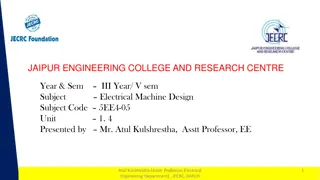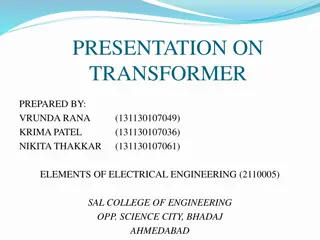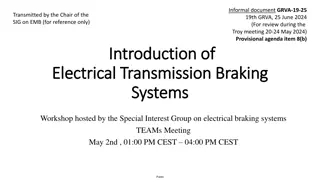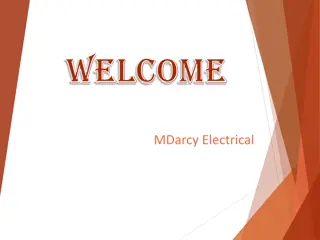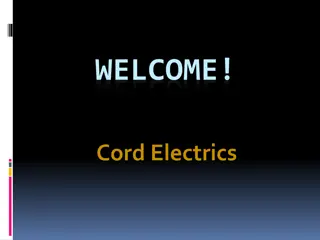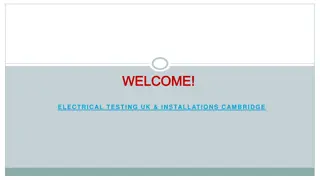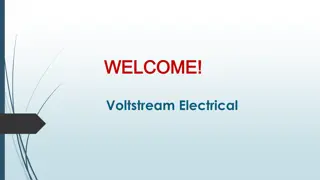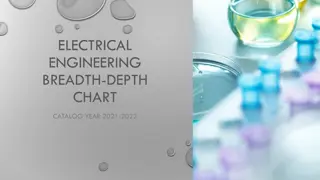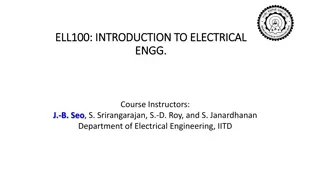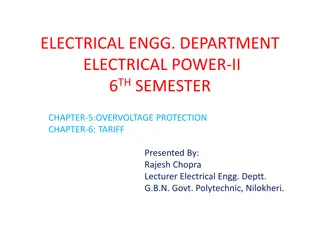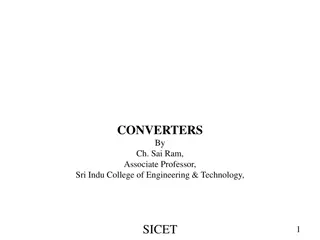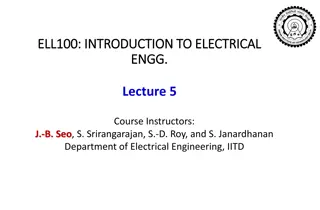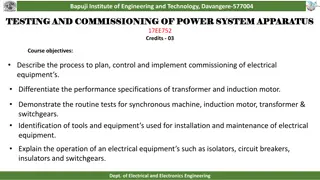
Introduction to Electrical Engineering: Complete Response
Introduction to the concept of complete response in electrical engineering, covering natural response, forced response, and the addition of both components. The lecture also includes examples and step responses of RL and RLC circuits.
Download Presentation

Please find below an Image/Link to download the presentation.
The content on the website is provided AS IS for your information and personal use only. It may not be sold, licensed, or shared on other websites without obtaining consent from the author. If you encounter any issues during the download, it is possible that the publisher has removed the file from their server.
You are allowed to download the files provided on this website for personal or commercial use, subject to the condition that they are used lawfully. All files are the property of their respective owners.
The content on the website is provided AS IS for your information and personal use only. It may not be sold, licensed, or shared on other websites without obtaining consent from the author.
E N D
Presentation Transcript
ELL100: INTRODUCTION TO ELECTRICAL ELL100: INTRODUCTION TO ELECTRICAL ENGG. ENGG. Lecture 10 Course Instructors: J.-B. Seo, S. Srirangarajan, S.-D. Roy, and S. Janardhanan Department of Electrical Engineering, IITD
Complete Response Complete Response Natural response Energy storage elements The form of natural response is governed by circuit itself Use poles and zeros of the impedance function Forced response External sources, e.g., batteries or generators The amplitude of forced response is determined by the magnitude of the forcing function and impedance Complete response = Natural response + Forced response 2
Complete Response Complete Response Natural response Energy storage elements The form of natural response is governed by circuit itself Use poles and zeros of the impedance function Forced response External sources, e.g., batteries or generators The amplitude of forced response is determined by the magnitude of the forcing function and impedance Complete response = Natural response + Forced response 3
Complete Response Complete Response Natural response Energy storage elements The form of natural response is governed by circuit itself Use poles and zeros of the impedance function Forced response External sources, e.g., batteries or generators The amplitude of forced response is determined by the magnitude of the forcing function and impedance Complete response = Natural response + Forced response 4
Complete Response Complete Response Natural response Energy storage elements The form of natural response is governed by circuit itself Use poles and zeros of the impedance function Forced response External sources, e.g., batteries or generators The amplitude of forced response is determined by the magnitude of the forcing function and impedance Complete response = Natural response + Forced response 5
Complete Response Complete Response Natural response Energy storage elements The form of natural response is governed by circuit itself Use poles and zeros of the impedance function Forced response External sources, e.g., batteries or generators The amplitude of forced response is determined by the magnitude of the forcing function and impedance Complete response = Natural response + Forced response 6
Complete Response Complete Response 7
Complete Response Complete Response 8
Complete Response Complete Response 9
Complete Response Complete Response 10
Complete Response Complete Response Write the impedance function (or admittance) Determine the forced response from the forcing func. Identify the natural response from poles and zeros with undetermined constants Add the forced and natural responses and evaluate the undetermined constants 11
Complete Response Complete Response Write the impedance function (or admittance) Determine the forced response from the forcing func. Identify the natural response from poles and zeros with undetermined constants Add the forced and natural responses and evaluate the undetermined constants 12
Complete Response Complete Response Write the impedance function (or admittance) Determine the forced response from the forcing func. Identify the natural response from poles and zeros with undetermined constants Add the forced and natural responses and evaluate the undetermined constants 13
Complete Response Complete Response Write the impedance function (or admittance) Determine the forced response from the forcing func. Identify the natural response from poles and zeros with undetermined constants Add the forced and natural responses and evaluate the undetermined constants 14
Step response of RL circuit Step response of RL circuit 15
Step response of RL circuit Step response of RL circuit 16
Step response of RL circuit Step response of RL circuit 17
Step response of RL circuit Step response of RL circuit 18
Step response of RL circuit Step response of RL circuit 19
Step response of RL circuit Step response of RL circuit 20
Example Example 21
Example Example 22
Example Example 23
Example Example 24
Example Example Previous solution 25
Example Example Previous solution 26
Example Example Previous solution 27
Example Example Previous solution 28
Example Example Previous solution 29
Example Example 30
Example Example 31
Example Example 32
Example Example 33
Example Example 34
Step response of RLC circuit Step response of RLC circuit 35
Step response of RLC circuit Step response of RLC circuit 36
Step response of RLC circuit Step response of RLC circuit 37
Step response of RLC circuit Step response of RLC circuit 38
Step response of RLC circuit Step response of RLC circuit 39
Step response of RLC circuit Step response of RLC circuit 40
Step response of RLC circuit Step response of RLC circuit 41
Example Example 1 1 42
Example Example 1 1 43
Example Example 1 1 44
Example Example 1 1 45
Example Example 1 1 46
Example Example 1 1 47
Example Example 1 1 48
Example Example 1 1 49
Example Example 1 1 50

